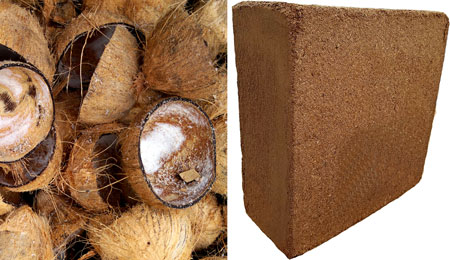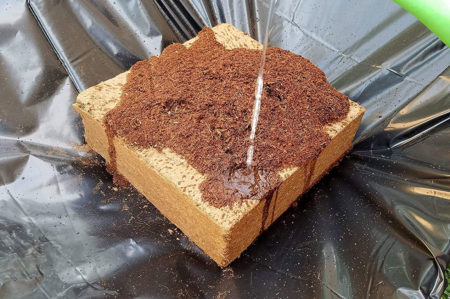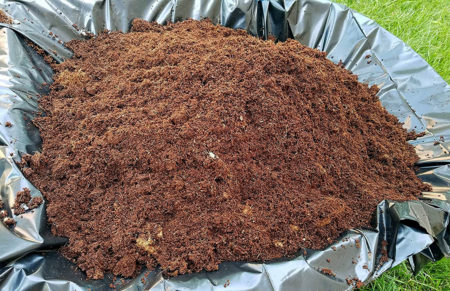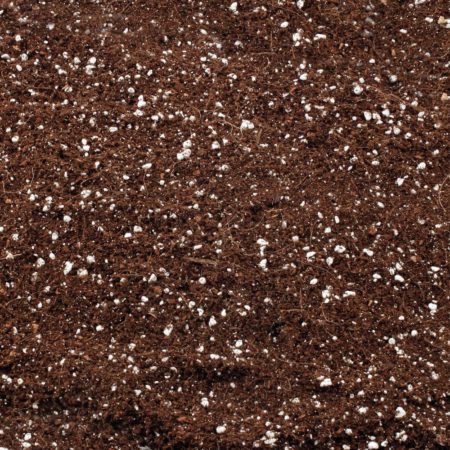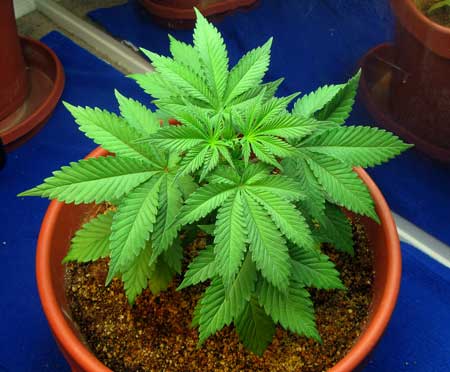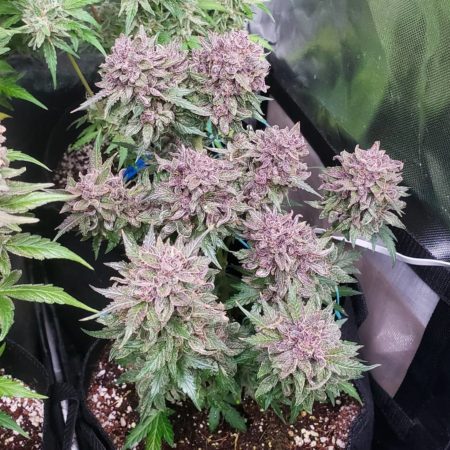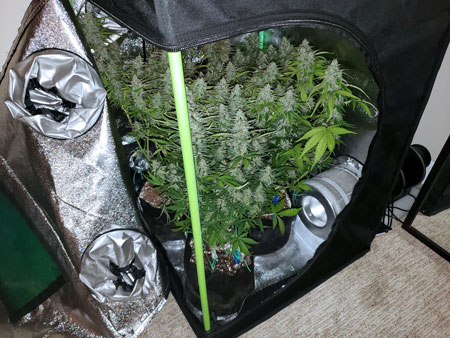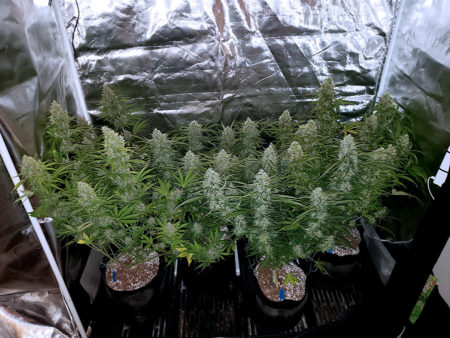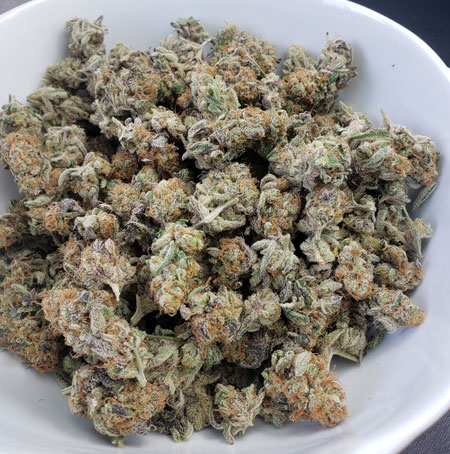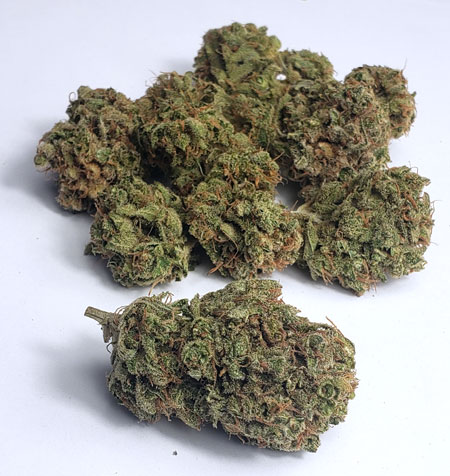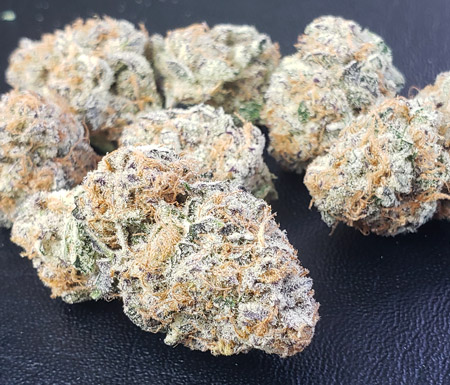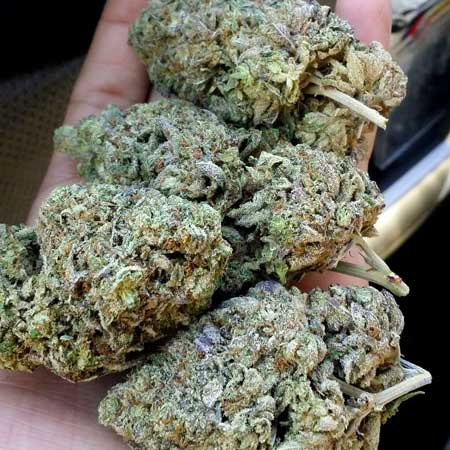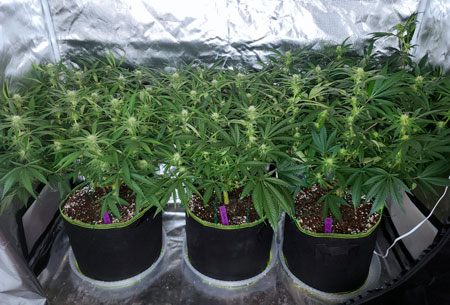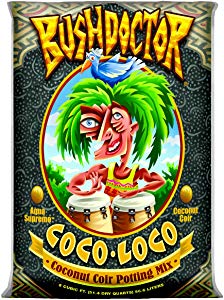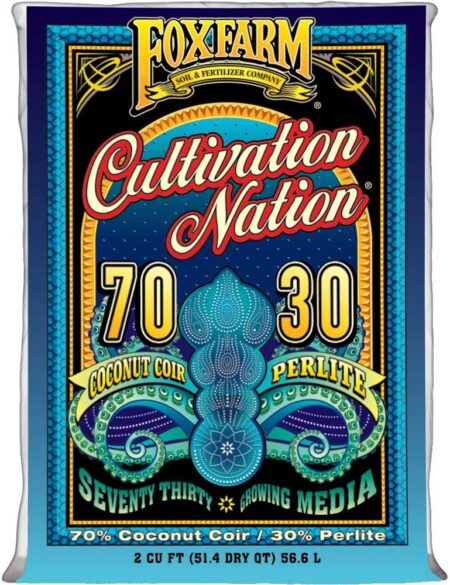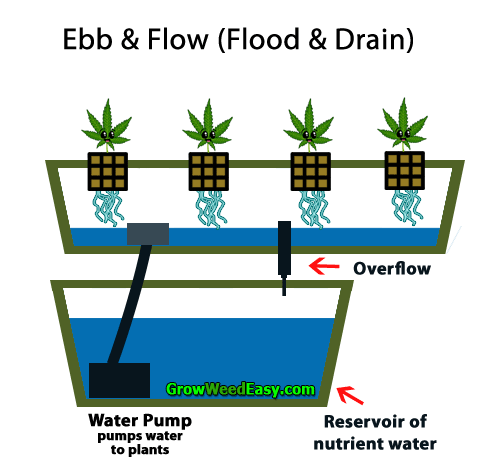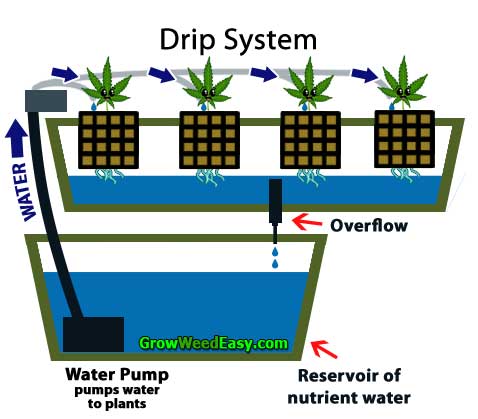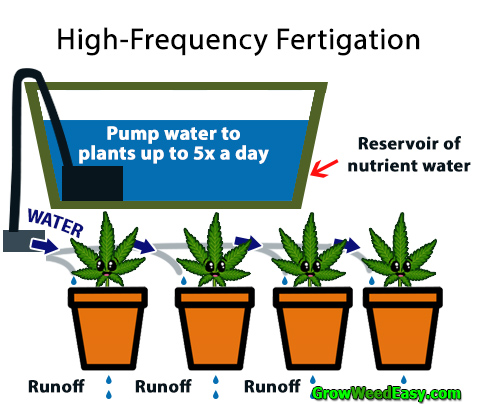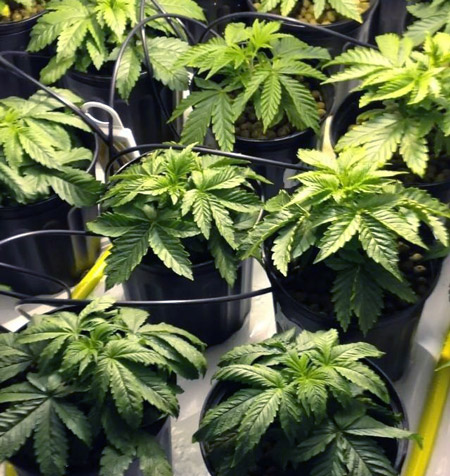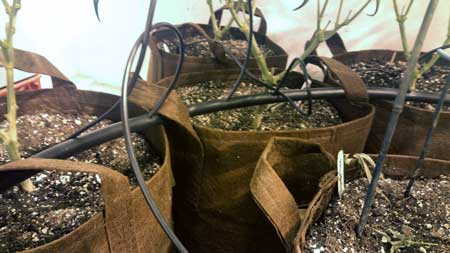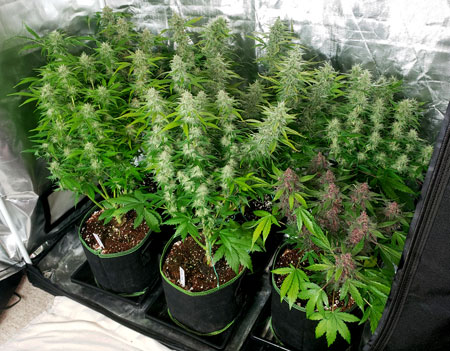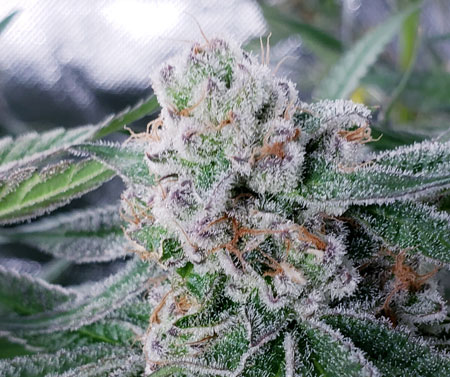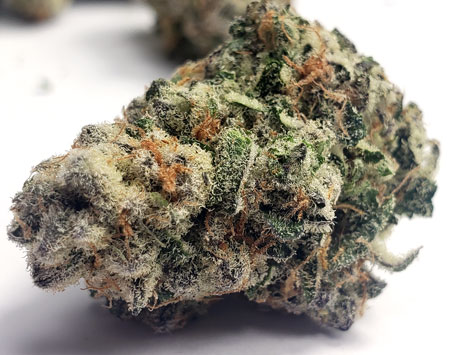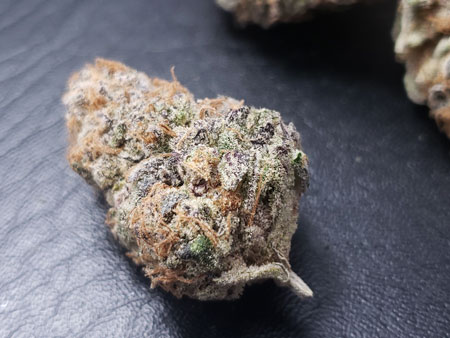by Nebula Haze
Coco coir (often referred to simply as “coco”) is the most flexible grow medium. Made out of coconut shells that would otherwise be thrown away, this unique substance has surprising benefits for cannabis plants.
Coco coir is made of coconut husks that have been ground up. It is often sold as compressed bricks for easy shipping and storage.
When water is added, it slowly expands into a substance that looks like pale soil
Pure coco coir after it’s been rehydrated
Many growers add up to 50% perlite (airy white rocks) to loosen the coco and create air pockets that help plants grow faster.
Cannabis plants thrive in coco in a variety of setups
Coco produces excellent bud quality! I grew all these buds in coco coir.
- No Bugs – Plants are much less likely to get bugs in coco than growing in soil because the material is inert. Many bugs need soil as part of their life cycle. It’s possible to get bugs in bad conditions such as extreme overwatering (which can result in fungus gnats), but coco bug infestations are unlikely in regular conditions.
- Doesn’t Stink – Regular potting soil has a pretty mild earthy smell, but most “just add water” soils contain stinky amendments like guano which can make your grow room smell foul. On the flip side, coco has basically no smell.
- Fast Growth – Coco plants have the potential to grow faster than soil with certain techniques. As fast as hydroponic plants in some setups.
- Precise Nutrient Control – Coco offers total control over nutrient ratios and nutrient strength. Perfect for growers who like being involved with their plants.
- Friendly to Environment – Coco is a renewable resource that would otherwise be thrown away.
- Learning – Growing in coco is a lot like soil when it comes to watering, yet a lot like hydro when it comes to nutrients. As a result, growing in coco prepares you for both soil and hydro growing if you decide to try something else in the future.
- Flexibility – Coco can be used in many different ways with great results. There’s more room for experimentation than with soil or hydro.
Cons of Coco Coir
- Needs Nutrients – Coco does not contain any nutrients on its own, so you must add nutrients in the water for healthy growth. While mixing up nutrients is fun and exciting for some growers, others find the process too complicated or time-consuming.
- Environmental Concerns – Coco itself is excellent for the environment, especially when using pure coco and only a moderate amount of nutrients. However, coco potting mixes often contain perlite, a non-renewable resource made of expanded volcanic glass (then again, most soil mixes also contain perlite). Some growers have started replacing perlite with environmentally friendly rice hulls, though I haven’t tried that yet. Additionally, if you’re using tons of nutrients (for example with a high-frequency fertigation schedule, discussed below), you may have to dispose of a lot of nutrient water runoff. Dumping nutrient-filled water into our water system isn’t great for the environment.
- Room for Error – Ultimately, coco creates more judgment calls than soil. There isn’t a nutrient buffer like in soil to help make up for mistakes when giving nutrients. It’s important to follow directions for the best results with coco. If you’re looking for the simplest way to grow, a “just add water” soil might be a better choice.
The coco plants I’m growing right now are in FoxFarm Cultivation Nation 70/30 Coconut Coir & Perlite with the Flora trio + CaliMagic as nutrients (here’s my nutrient schedule). These plants have been in the flowering stage (on 12/12) for only 19 days and look at all those buds already!
Ways to Use Coco
As an Amendment – mix coco into actual soil as an amendment
- Coco can be added to regular soil to improve its quality
- Coco is better for the environment than non-renewable peat moss (which is what coco usually replaces in a soil recipe) and works better for growing cannabis
For example, Coco Loco is a soil that contains coco instead of peat moss. I’ve found Coco Loco is one of the easiest grow mediums to start cannabis plants in. In my experience, young plants and seedlings seem to grow faster in Coco Loco than popular peat-based soils like Happy Frog or Ocean Forest. Coco Loco is a great option with a good mix of the benefits of both coco and soil.
Coco Loco is a mix of soil and coco. Get the best of both worlds!
Treat Coco Like Soil – water every few days with nutrient water
When using pure coco or a coco/perlite mix, you can treat it basically like soil as long as you’re giving nutrients in the water.
- Easy
- Efficient nutrient use
- Less time mixing nutrients
- Little nutrient water runoff to dispose of (better for the environment)
- Use bigger pots to water less often
- Learn how to grow cannabis this way
FoxFarm Cultivation Nation 70/30 Coconut Coir & Perlite can be used straight out of the bag. Just add plants and give coco-friendly nutrients! I’ve had excellent results with this brand.
Treat Coco Like Hydro – high-frequency fertigation, drip feeds, or flood-and-drain
In these types of setups, the coco is mainly there to anchor your roots while you treat the plants like they’re in a hydroponic setup.
- Fastest growth
- Frequent watering
- As often as multiple times a day
- Best to set up automatic watering on a timer
- Watch out for fungus gnats and droopiness from too-wet conditions (fix these issues by watering less at a time or less often until plants are drinking more)
- Use smaller pots and always add perlite to coco to prevent droopiness as well as get more oxygen to roots
Flood & Drain systems may use coco to anchor the plant roots. Nutrient water “floods” the plant roots multiple times via a timer and then drains. This combination gives roots a constant flow of both nutrient water and oxygen. These systems can be tough to get set up yet produce surprisingly fast growth once dialed in.
High-frequency fertigation and drip feed setups are similar. However, instead of nutrient water getting pumped in like a flood, it’s dripped to the plants via tubing.
In a traditional drip system, runoff water is pumped back into the main reservoir to be reused. However, the quality of the nutrient water goes down over time as plants use up nutrients.
To ensure plants are getting fresh nutrient water each time, the runoff water may be collected and disposed of (instead of putting runoff back into the system to be re-used)
Hybrid Approaches
- Anything in between
- Experimenting is fun
- Get a mix of benefits!
What is high-frequency fertigation?
Fertigation means adding nutrients to the water you give to your cannabis plants. Cannabis plants typically grow faster when they get nutrients from the water as opposed to seeking out nutrients in soil. When cannabis growers talk about fertigation, they’re often referring to high-frequency fertigation, which means watering plants with nutrient water frequently.
High-frequency fertigation means giving nutrient water to cannabis plants as often as 5x a day. When set up properly, marijuana plants typically grow faster in high-frequency fertigation than plants watered a few times a week.
Give water multiple times a day by using drip-lines that pump nutrient water to plants on a timer
High-frequency fertigation must use a grow medium that contains air pockets even when wet to prevent roots “drowning” from lack of oxygen. The most popular grow medium for high-frequency fertigation for cannabis is a coco + perlite potting mix (another option is clay pebbles/hydroton, which can handle watering even more often than coco).
In this grow style, cannabis plants are usually given nutrient water automatically on a timer via an automated drip-feed. Automatic irrigation will save a ton of time compared to hand-watering multiple times a day!
Quick tips:
- use well-draining potting mix (50/50 coco/perlite works well)
- use hydro or coco-specific nutrients (such as Canna Coco or Flora Trio)
- for more frequent fertigation, use smaller pots
- get an automatic watering system (you will forget if you try to hand-water!)
- give nutrients every watering
- try to ensure EC/PPM of water going in and out are about the same
- if plants look perpetually droopy give water less often or less water at a time until plants are drinking more
- maintain 5.5-6.5 pH of the water
- always remove runoff water or have it drain away (never let plants sit in runoff water).
Bonus tip: Your growing medium is important, but the secret to amazing bud quality is actually a combination of two other things… You must choose the right strain and give plants a great environment in the flowering stage.
Don’t ignore temperature or humidity problems when plants are making buds! As long as plants are healthy, the flowering environment determines whether genetics live up to their full potential.
And remember that regardless of anything else you do, you can’t grow outstanding buds without great genetics!
Check out American genetics for extra sparkly strain options!

